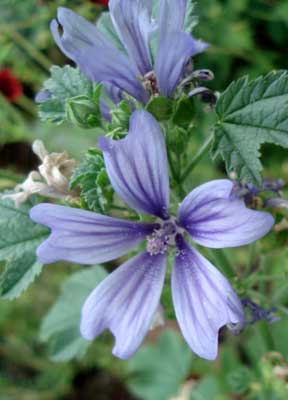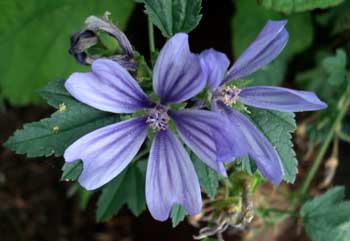
'Primley Blue'
Common Mallow
"Let olives be my food
& endive & mallows easy to digest."
-Horace
(65 B.C.E. - 8 B.C.E.)
Malva sylvestris 'Primley Blue' has cranesbill geranium-like flowers & the leaves that look like those of bush mallow (Althea officinalis).(65 B.C.E. - 8 B.C.E.)
I think this is a wonderful flower because I love cranesbills & anything that resembles them. Plus I like that this one flowers all summer & much of autumn without letting up.
Granny Artemis on the other hand thinks the leaves look too big, way too floppy & untidy & like they belong on a bush, not a short clumping perennial. And I can see her point; it's a flawed beauty.
'Primley Blue' has a purplish light blue flower with darkly penciled lines. Because the flowers are sterile, each bloom lasts an extra long time, being unable to turn to seed (so propogation is by division).
 It can sprawl to as much as three feet wide with its large, lobed grey-green leaves. It's usually only one-foot tall though a mature clump might well hump upon itself considerably taller.
It can sprawl to as much as three feet wide with its large, lobed grey-green leaves. It's usually only one-foot tall though a mature clump might well hump upon itself considerably taller.There are upright cultivars but 'Primley Blue' is prostrate. It will never stand upright, & it'll frustrate who tries to stake it & force it to do so. So place it somewhere that permits it to tumble & spill whatever direction it chooses.
It does well in a crowded border, holding its own & short enough not to smother more upright sun-perennials. We put one clump in a narrow trough that surrounds a much taller planter, & it spills out of the trough behind a blue sage. I think it looks great there.
It requires full sun & well-drained soil, but its drought tolerance shouldn't be tested in the hottest days of summer, when you'll need to get water to it to insure continuous floriferous behavior. It prefers a neutral pH or poor soil, & dislikes humusy rich soil. Rabbits & deer are not very fond of them, nor are cattle (though Virgil notes it being used as fodder for goats), but snails & numerous insects do like to nibble on the leaves.
In the ancient & medieval world, common mallow was used in the manner of hemp to produce a cloth called malbella, melocinea, & molocina, the fibres obtained from the leaves & stems. The cloth had a shimmering silk-like quality that induced Alcuin to the poetic line, "Wrapt in a mallow shawl, the lady shines." Such garments were colored with dyes also made from common mallow. The ancient Greeks used the fibres in basketweaving.
Native to the whole of Europe, M. Sylvestris has quite a lot of common names, including but by no means restricted to Common Mallow, Blue Mallow, Country Mallow, Wild Mallow, Malva, Grand Mauve, Wood Mallow, Garden Mallow, Round Dock, Varmetta, Maul, French Hollyhock, Cheese-Cake, Cheese-Flower, Pick-Cheese, or simply Cheeses.
Names alluding to cheese are for the seeds which look like cheese wheels, & are edible though bland. These of course won't be seen on sterile 'Primley Blue.' Such common names as High Mallow, High Cheesewheel, & Tall Mallow are to distinguish it from a low-growing species (M. pusilla), but is not an applicable distinction where low-growing 'Primley Blue' is concerned.
Besides the seeds eaten while still green, the leaves were formerly a common food item in many European households, generally used in soups as thickeners.
Such a meal was associated with the poor, as mallow could be gleaned from any meadow or field; but no less an author than Hesiod circa 700 B.C., counselling moderation, tells us only fools do not understand that a little mallow in one's diet is a thing of benefit [Opera et Dies 41], an observation made in contrast to the unhealthful effects of a richer diet.
Leaves, flowers, & roots have been used as a tea with health-tonic claims, & might function as a laxative if brewed strongly enough. The flowers can be used in salads & as decorative garnish.
See also:
Malva sylvestris var. mauritiana 'Bibor Fehlo' high mallow